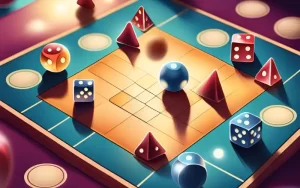Ludo has been a classic board game cherished by people of all ages. Whether you’re creating a custom game board to add a personal touch or restoring an old one, mastering the art of ludo drawing is essential. The visual appeal of your Ludo board significantly enhances the gaming experience, ensuring everyone enjoys the game. In this guide, we’ll dive into the best tips and hacks to create a perfect Ludo board, explore tools like ludope download, and understand how to draw ludo with ease.
1. Understand the Basics of a Ludo Board
Before diving into the actual ludo drawing, it’s crucial to understand the structure of a Ludo board. A traditional Ludo board comprises a square divided into four quadrants, each representing a player’s territory. Each quadrant contains a base, a home triangle, and paths leading to the center, where the “finish” resides.
The game board also includes a cross-shaped layout with colored pathways for each player. The four standard colors are red, blue, yellow, and green. Familiarizing yourself with this setup ensures you don’t miss any critical elements while drawing.
2. Tools You’ll Need for Ludo Drawing
Creating a visually appealing Ludo board requires precise tools. Here’s a list of essentials:
- Graph paper: Ideal for maintaining symmetry and proportions.
- Ruler: Ensures straight and clean lines.
- Compass: Useful for drawing perfect circles.
- Pencils: For initial sketches.
- Markers and colored pencils: To fill in the board with vibrant colors.
- Stencil (optional): Helps with intricate designs.
For digital enthusiasts, using apps like ludope download can simplify the process. These tools provide pre-designed templates and patterns, making it easier to replicate the classic Ludo board.
3. Steps to Draw a Perfect Ludo Drawing
Let’s break down how to draw ludo into simple steps:
Step 1: Prepare Your Base
Start with a square base. If you’re using a physical medium, a piece of cardboard or sturdy paper works best. For digital designs, open a drawing application or utilize templates available in tools like ludope download.
Step 2: Divide the Board
Using a pencil and ruler, divide the square into four equal quadrants. Each quadrant should be a square that will house one player’s area.
Step 3: Draw the Cross
Within the divided quadrants, draw a cross-shaped pathway. The central part of the cross is the neutral zone, leading to the center “finish” square.
Step 4: Add Bases and Paths
Each quadrant requires:
- A base or starting area for player tokens.
- A pathway leading to the finish zone.
- A home triangle at the end of the pathway.
Step 5: Add Colors
Fill in the quadrants and pathways with the standard Ludo colors (red, blue, yellow, and green). You can customize these colors to your liking if you’re creating a personalized board.
Step 6: Mark the Safe Zones
Safe zones are critical spots on the board where player tokens cannot be captured. Typically, these are marked with circles or distinct symbols.
4. Hacks for a Professional Finish
To make your ludo drawing stand out, try these professional hacks:
- Use Pre-Made Templates: Download templates or use tools like ludope download to save time and effort.
- Digital Design Software: Apps such as Adobe Illustrator or Canva allow you to design precise and visually appealing boards.
- Laminating Your Board: After completing the drawing, laminate it for durability and a professional look.
Here’s a visual representation of the traditional Ludo board layout for better clarity:
| Section | Details | Tips |
| Player Quadrants | 4 colored areas | Use stencils for uniform shapes. |
| Pathways | Cross-shaped grid | Maintain symmetry using graph paper. |
| Safe Zones | Circular or marked spaces | Add symbols for clear identification. |
| Finish Area | Central square | Highlight this area with bold colors. |
5. Personalizing Your Ludo Board Drawing

Customizing your Ludo board adds a unique charm to your game. Here are some ideas:
- Thematic Designs: Choose themes such as superheroes, nature, or cultural motifs. For instance, replace the standard colors with customized patterns.
- Family Names or Initials: Add personal touches by inscribing family names or initials in each quadrant.
- 3D Effects: Experiment with shading techniques or digital effects for a modern look.
Personalization becomes effortless when you explore digital options with ludope download, which offers a variety of design tools to create custom Ludo boards.
6. Common Mistakes to Avoid
When learning how to draw ludo, it’s easy to make mistakes that compromise the board’s functionality. Here are some common pitfalls and how to avoid them:
- Uneven Lines: Always use a ruler for straight edges and symmetrical divisions.
- Mismatched Colors: Stick to a consistent color palette to maintain the traditional aesthetic.
- Overcrowding the Board: Ensure enough space for tokens to move without confusion.
- Incorrect Measurements: Double-check dimensions to prevent errors.
7. Digital Ludo Drawing: A Game Changer
For tech-savvy creators, digital platforms simplify the process of designing a Ludo board. Tools like ludope download offer pre-set templates and editing options. Here’s why you should consider going digital:
- Precision: Achieve perfect symmetry and alignment effortlessly.
- Customization: Experiment with endless themes, colors, and designs.
- Ease of Sharing: Share your designs with friends or print them for use.
8. Maintaining Your Ludo Board
Whether you’ve crafted a physical or digital board, maintenance is essential to ensure longevity:
- Physical Boards: Protect the surface by laminating it or using a clear protective sheet.
- Digital Boards: Save your files in high resolution and back them up on multiple devices.
9. Why Ludo Drawing Matters
You might wonder why you should invest time and effort in perfecting your ludo drawing. A well-crafted board enhances the gaming experience, making it visually pleasing and functional. Additionally, creating your own board allows you to bond with family and friends over a shared creative activity.
10. The Role of Apps in Ludo Design
Apps like ludope download revolutionize how we design and create Ludo boards. These platforms offer intuitive tools for beginners and professionals alike, ensuring anyone can master how to draw ludo without prior experience.
Conclusion
Mastering ludo drawing is a rewarding process that combines creativity with functionality. By following these tips and leveraging tools like ludope download, you can create stunning and customized how to draw Ludo boards that elevate your gaming sessions. Whether you’re drawing by hand or digitally designing, the key is attention to detail and a dash of personalization.
So, what are you waiting for? Grab your tools or explore digital platforms to craft your dream Ludo board today!







